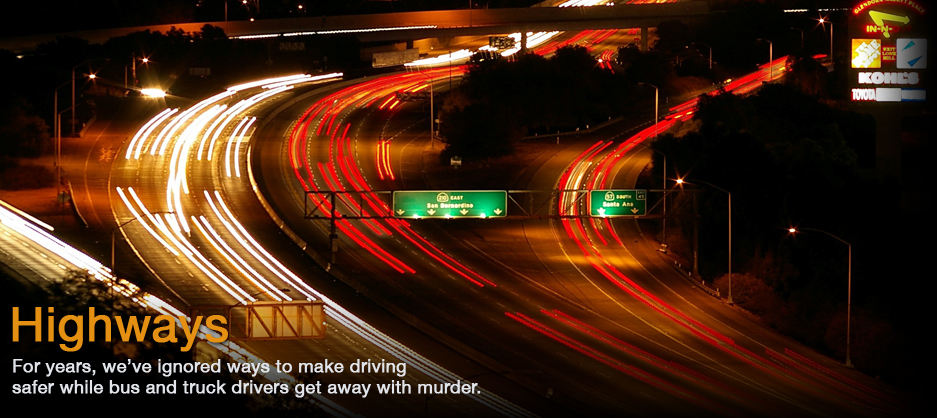Cable Barriers
If roundabouts are the higher-cost, generally effective treatment for cities and rumble strips the cheap but highly effective design on rural roads, cable median barriers offer safety on the cheap for divided highways everywhere.
But while cable median barriers are one of the more popular roadway safety improvements, highway engineers and safety advocates heatedly debate their effectiveness.
In the past seven years, 20,000 cable median barriers have been installed across the country. Part of the reason is cost: A cable median barrier costs $12 to $15 per square foot compared to concrete median barrier’s cost of about $80 per square foot.
“Cable median barriers are taking off because of how cost effective they are and the positive returns you get for such a low installation price,” said Cody Stolle, a graduate student the University of Nebraska-Lincoln and engineer at its Midwest Roadside Safety Facility.
Supporters say the barriers produce a 95 percent reduction in median crossover accidents, but the remaining five percent result in horrendous, often fatal accidents. When a cable barrier failure occurs and an accident is the result, it often involves two or more vehicles colliding head-on at high speeds, as did the one involving young Kate Zoromoski five years ago.
Zoromski was eager for a hot meal after cheerleading practice. She merged onto I-43 and headed for the nearest International House of Pancakes, 10 miles away, as she had countless times before.
Two miles later, Zoromksi lost control of her Mazda sedan and slid beneath the cable median barrier into oncoming traffic. The crash killed her, two of her passengers and left one survivor facing a grueling recovery. The crash resulted in a pileup that caused four additional injuries.
The town of Grafton is a church-bound community of 12,000 that felt the ripple effect of the accident far beyond the front page of the newspaper. The magnitude of grief was palpable – as was the level of incredulity.
People began to question the integrity of a cable barrier that was installed a year prior to the accident with the price tag of $525,000.
“How there can by a safety measure in place that allows a car to pass underneath the barrier is beyond me,” said Mark Zoromski, Kate’s father. “The physics of it just don’t make sense to me. Breaking through the barrier – well, maybe. Passing under it… I can’t wrap my head around it.”
The Wisconsin State Patrol and the Wisconsin Department of Transportation launched an investigation, ultimately blaming flaws in the engineering, design and construction of the cable median barrier.
The area’s deep freezes and quick thaws can saturate the ground with moisture. Ozaukee County officials admitted that the ground was soggy when they built the barrier, contrary to a Federal Highway Administration mandate green-lighting the project, which stated that the ground was secure and did not possess any alarming characteristics that would deter construction.
Despite the discrepancy, Mark Zoromski did not file a lawsuit. Instead, he has turned his focus to educating officials on cable barrier safety standards so another tragedy can be averted.
The barriers are designed to have no more than 21-inch gaps between each cable as well as from the ground to the lowest cable. Gaps in the I-43 barrier ranged from 24 to 33 inches, investigators found. The front bumper of Zorokowski’s Mazda was 21 inches high, allowing it to wedge underneath the cable with enough force to pass through.
Because posts were set 19 feet as opposed to 16 feet apart, the cables lacked proper tension to stop a car. The county also built a three-cable barrier, rather than a four-cable system, which is scientifically stronger, according to the State Patrol Accident Reconstruction Report.
Still, engineers for the state of Washington concluded that the cable median barriers, when properly installed, are better than the alternatives. They analyzed 11,457 median barrier collisions within the state from 1999 to 2004 and found that cable median barrier crashes recorded a 16 percent chance of injury or death compared to concrete median barrier’s 40 percent. Scientifically, cable median barriers are more effective.
Mark Zoromski finds no solace in the statistics.
“I miss (Kate) every day,” he said. “Coping is painful. I cry all the time. I really miss her. To think that such a simple fix as having a fourth cable or lowering the height of the lowest cable could have saved her kills me inside.”
Three and a half years later, a fourth cable median barrier has not been added to the stretch of barriers where Zoromski and her two friends died.
The state was supposed to test the effectiveness of installing a fourth cable median barrier in 2009 to determine whether it would be worth the price to install. But the test costs $50,000, and each time it has been suggested, the state has been unable to come up with the money.
“Nobody has put a priority on improving this stretch of cable median barriers or making it a requirement that they have four (cables) to begin with,” Mark Zoromski said. “In the meantime, I pray it doesn’t happen again… to somebody else.”


 In No Shape to Drive
In No Shape to Drive